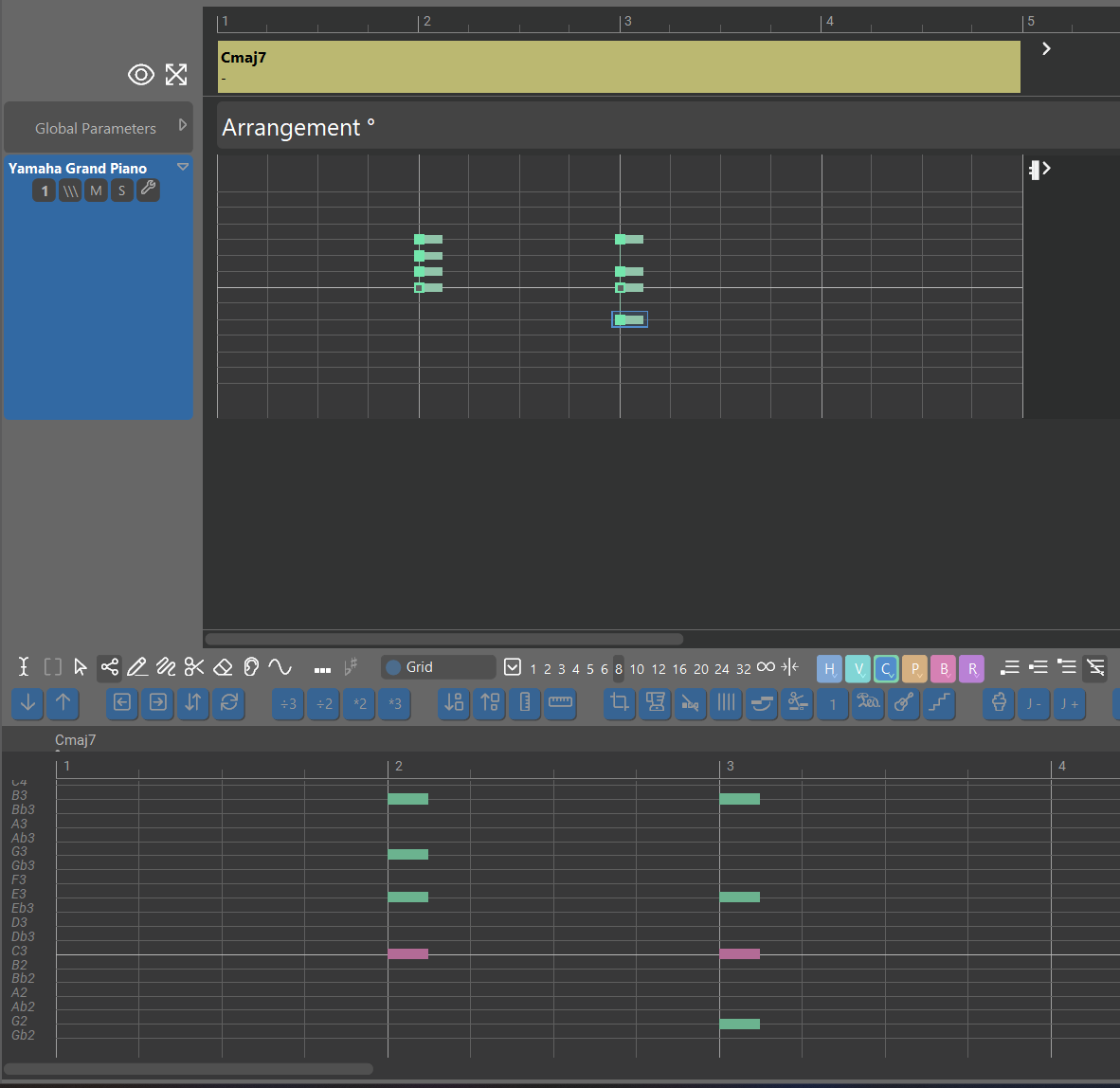
Posted
The more I use SF and study the excellent manual, the more I seem to have understood how different figure symbols and anchors translate into rendered notes.
One thing I do still struggle with is controlling chord voicing, beyond SFs automatic auto-magic.
Here‘ a minimal example:
I have a simple I - V diatonic vamp in c major using 7ths chords (so c major7th and g dominant 7th).
How do I modify the usual chord symbols (default 4 stacked chord symbols with anchor on 0 line), such that we get a drop 2 voicing?
Can I encode this in figure (mangling some of the figure elements and/or anchor) or do I also have to tweak interpretation, if latter please explain as well.
Thx a lot.
Wed, 2024-05-15 - 10:58 Permalink
The green symbols map to the current inversion of the chord (1st, 2nd, 3rd, note starting from bottom note according to the inversion).
I'm not a guitarist. As far as I understand Drop 2 denotes a particular chord inversion. You can set a desired inversion in the Harmony parameter (as a default) or for each Figure segment individually.
Wed, 2024-05-15 - 16:34 Permalink
Apologies for being so pushy, still not sure how to achieve it with SF - please be more specific - thx, sorry :-)
Drop 2 (source: https://pianowithjonny.com/piano-lessons/drop-2-piano-voicings-the-complete-guide/ )
Drop 2 voicings (a.k.a. “drop 2 chords”) are 4-note open position chord voicings in which the outer notes are a spaced a 10th interval apart, or in some cases a 9th. The specific drop 2 spacing is accomplished by first beginning with a 4-note closed position voicing and then dropping the 2nd note from the top down an octave. Jazz pianists and guitarists frequently use drop-two voicings when playing chord melodies and while comping behind a soloist.
Wed, 2024-05-15 - 18:33 Permalink
Pick an inversion that makes the desired "2nd from above" (counted in root position, as I understand it) the lowest note. Inversion always transposes notes by an octave.
If that doesn't make the desired voicing, we might need to add this as an extra item to the inversions menu.
The issue is, the "2nd from above" note can be any interval depending on the chord type and number of extensions you added. It is usually the 5th but may also be a 4th, 6th, 7th, 9th (even the 11th, if you have a 13th chord).
Wed, 2024-05-15 - 19:49 Permalink
Pick an inversion that makes the desired "2nd from above" (counted in root position, as I understand it) the lowest note.
No, you can't achieve these drop 2 and drop 3 voicings just by inversion. Actually you can use any inversion and create a drop 2 and drop 3 version of it.
So you would need to work with sub-options additionally to the inversions if you want to add these voicings to the menu. It's probably easier to draw the desired voicing manually in the phrase editor.
Wed, 2024-05-15 - 21:05 Permalink
Thx juergen, I had the same hunch, but its great that you confirm it:
It's probably easier to draw the desired voicing manually in the phrase editor.
How would you then encode Drop 2 for the C maj7, G dominant 7 progression as orginally posted in SF with manual drawing?
Can you screenshot the figure?
Thx a lot, I am keen to learn how much SF is capable to support me writing jazz.
Wed, 2024-05-15 - 22:01 Permalink
If you want to create a drop 2 voicing starting from a seventh chord in root position, then simply draw a four-note chord in root position in the phrase editor (as here in bar 2) and then drag the second symbol from above to the second line below the center line (as here in bar 3). This note (here the note g) is then transposed down an octave (as seen at the output parameter display below).

Thu, 2024-05-16 - 11:06 Permalink
Actually you can use any inversion and create a drop 2 and drop 3 version of it.
Thanks. I suspected this but wasn't sure how the concept is used in practice. That makes it even more interesting. Simple post-processing of the final (closed voiced) chord, whatever it is. If this is a common use case, adding a checkbox or popup might make sense.
Inverting one of the higher notes down however can't be defined on the basis of intervals. It's a blind transformation with no predictable harmonic outcome (just timbre).
Thu, 2024-05-16 - 11:28 Permalink
Drop 2 and drop 3 voicing are pretty common in Jazz to add variation and offering optionfor bass lines, often resulting in line cliche. It would be a great feature to have a UI option switch extending SFs capability and simplify workflow.
@andre: pls consider - thx.
Texture series: Drop voicing.
Thu, 2024-05-16 - 14:20 Permalink
Inverting one of the higher notes down however can't be defined on the basis of intervals. It's a blind transformation with no predictable harmonic outcome (just timbre).
With octave doubling , the harmonic function remains.
Would you take a 3 note or 4 note chord and apply octave doubling to it for the notes that lend themselves to it.


